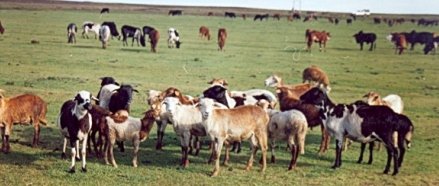
Some of Ethiopia’s domestic animal diversity (Photo: EBI Public Realtion & Communication Directorate)
Ethiopia has served as a gateway to domestic animals from Asia to Africa and its diverse ecology favored diversification of these resources. In terms of livestock population, Ethiopia stands first in Africa and 10th in the world in livestock population. The domestic animal population of the country is estimated to be 47.5 million cattle, 26.1 million sheep, 21.7 million goat, 1 million camel, 39.6 million chickens, 1.8 million horses, 0.4 million mules and 5.6 million donkeys (CSA, 2009). The trends in population size of these livestock over the last five years are presented in Figure 10a and 10b. The change in population size has shown remarkable positive trends in all cases. Though increase in population size doesn’t necessarily show the state of the animal diversity; given more than 99% of the livestock population (excepting poultry) being indigenous breeds, it appears that the resource is thriving well. However, the trend and the state of individual breeds need to be scrutinized, since some of the breeds are threatened. At present there are about 30 cattle, 14 sheep, 14 goat, four camel, four donkey, two horse, two mule, five chicken and five honey bee breeds/strains/populations. It is reported by Somali Region Pastoral and Agropastoral Research Institute (SORPARI) that there are two humped camel breeds and a feral horse population in the region. There is also another feral horse population in the eastern part of Oromia region. However, the status and trend of most of the breeds is not known. At the moment Sheko cattle, the only taurine breed in East Africa, appears to be highly threatened as a result of interbreeding with the local zebu and change in the system of production (Box 8). The Fogera, Begayit, Irob, Ogaden, Afar and Borena cattle breeds, Sinnar donkey breed, and Afar sheep breed are also facing various degrees of threat.
The major threats to the livestock genetic resource include feed shortage as a result of degradation of rangelands/grazing areas, overgrazing and overstocking; sporadic invasion of rangelands by weeds and shrubs, expansion of crop cultivation, illegal trafficking, inbreeding and interbreeding and Trypanosomiasis. The major threats to indigenous chicken are replacement by exotic breeds, diseases and predation while the major threats to honeybees are agro-chemicals (pesticides/herbicides) diseases, pests and predators.
Some indigenous domestic animals (e.g. Sheko and Ogaden cattle) are interbreeding with other breeds and are losing their unique features. In addition, drought, desertification and abandoning of irrigated areas due to salinity are affecting the pastoralists and possibly the animal genetic resource. Crossbreeding of Menz sheep with Awasi exotic breed is likely to dilute the indigenous Menz sheep breed. Boran cattle breed is also a subject of dilution as a result of crossbreeding and replacement by other breeds during restocking after drought. Introduction of new breeds to a new area is also resulting in appearance of diseases which were not recorded before. Gumboro is a disease of poultry which is being seen in Ethiopia only since recent times.
As a result of increased market demand, the number of cattle, goat, sheep and camel being exported legally and illegally seems to threaten the resource since the size of export is not commensurate the off-take rate. This can be verified by the large proportion of young and breeding animals supplied to the market. Conservation of the domestic animal diversity is not getting the attention it deserves.
Fogera cattle breed is interbreeding with other cattle breeds and consequently the pure line is declining. Ranches were established in Chagni, Metekel and Angasa for this breed with major objectives of breed
improvement and retaining the pure lines. A ranch was also established for Washera sheep in north western Ethiopia (Amhara region).
The national artificial insemination coverage for cattle is 1%. Exotic or crossbreed bulls, chicken and sheep are also distributed to some parts of the country. Excepting poultry the level of current introduction is low and for cattle is mainly restricted to urban areas. However with the aggressive extension program to increase the artificial insemination service and due to more focus on certain breeds and areas there is serious threat of dilution to some local population.
